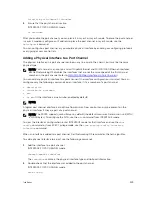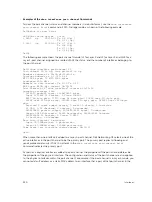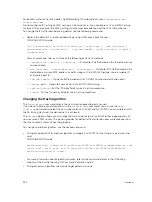
Dell#
Assigning an IP Address to a Port Channel
You can assign an IP address to a port channel and use port channels in Layer 3 routing protocols.
To assign an IP address, use the following command.
• Configure an IP address and mask on the interface.
INTERFACE mode
ip address
ip-address mask
[secondary]
–
ip-address mask
: enter an address in dotted-decimal format (A.B.C.D). The mask must be in
slash format (/24).
–
secondary
: the IP address is the interface’s backup IP address. You can configure up to eight
secondary IP addresses.
Deleting or Disabling a Port Channel
To delete or disable a port channel, use the following commands.
• Delete a port channel.
CONFIGURATION mode
no interface portchannel
channel-number
• Disable a port channel.
shutdown
When you disable a port channel, all interfaces within the port channel are operationally down also.
Load Balancing Through Port Channels
Dell Networking OS uses hash algorithms for distributing traffic evenly over channel members in a port
channel (LAG).
The hash algorithm distributes traffic among Equal Cost Multi-path (ECMP) paths and LAG members. The
distribution is based on a flow, except for packet-based hashing. A flow is identified by the hash and is
assigned to one link. In packet-based hashing, a single flow can be distributed on the LAG and uses one
link.
Packet based hashing is used to load balance traffic across a port-channel based on the IP Identifier field
within the packet. Load balancing uses source and destination packet information to get the greatest
advantage of resources by distributing traffic over multiple paths when transferring data to a destination.
Dell Networking OS allows you to modify the hashing algorithms used for flows and for fragments. The
load-balance and hash-algorithm commands are available for modifying the distribution algorithms.
NOTE: Hash-based load-balancing on multi-protocol label switching (MPLS) does not work when
you enable packet-based hashing (
load-balance ip-selection packet-based
).
Load-Balancing Method
For LAG hashing on the source IP, destination IP, source transmission control protocol (TCP)/user
datagram protocol (UDP) port, and destination TCP/UDP port are used for hash computation by default.
Interfaces
333
Summary of Contents for Z9000
Page 1: ...Dell Configuration Guide for the Z9000 System 9 7 0 0 ...
Page 80: ...grub reboot 80 Management ...
Page 128: ... 0 Te 1 1 Te 1 2 rx Flow N A N A 128 Access Control Lists ACLs ...
Page 491: ...Figure 70 Configuring OSPF and BGP for MSDP Multicast Source Discovery Protocol MSDP 491 ...
Page 496: ...Figure 73 MSDP Default Peer Scenario 1 496 Multicast Source Discovery Protocol MSDP ...
Page 497: ...Figure 74 MSDP Default Peer Scenario 2 Multicast Source Discovery Protocol MSDP 497 ...
Page 498: ...Figure 75 MSDP Default Peer Scenario 3 498 Multicast Source Discovery Protocol MSDP ...
Page 760: ...Figure 100 Single and Double Tag TPID Match 760 Service Provider Bridging ...
Page 761: ...Figure 101 Single and Double Tag First byte TPID Match Service Provider Bridging 761 ...






























